2018-09-06 - Nº 175
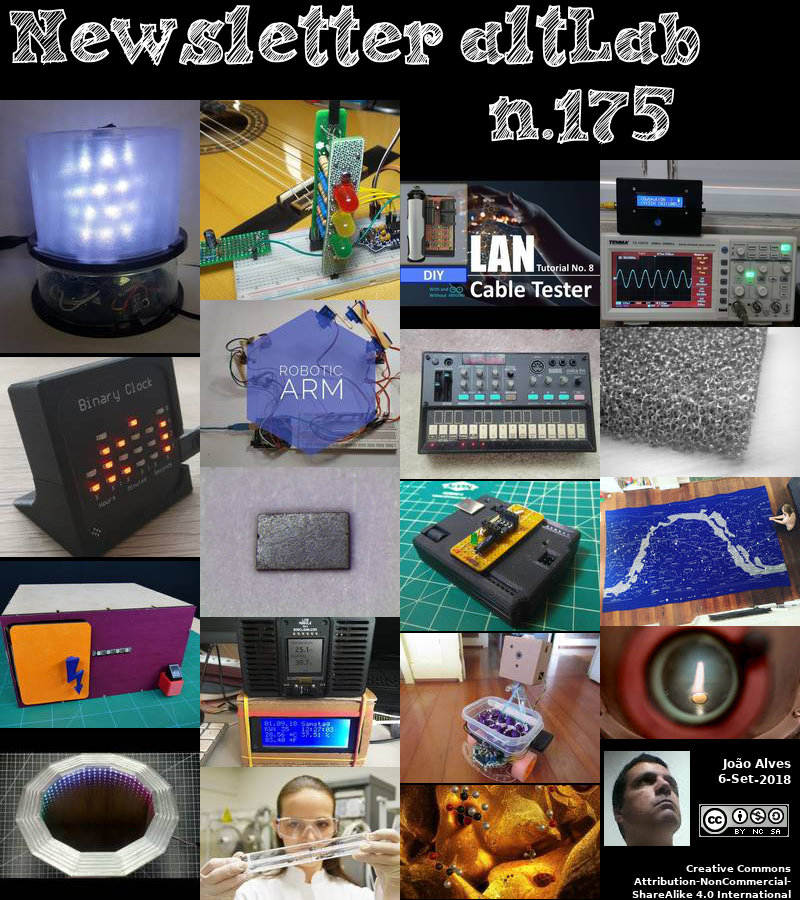
Editorial
Esta é a Newsletter Nº 175 que se apresenta com o mesmo formato que as anteriores. Se gostar da Newsletter partilhe-a!
Todas as Newsletters encontram-se indexadas no link.
Esta Newsletter tem os seguintes tópicos:
Faz hoje anos que nascia, em 1766, John Dalton. Este químico, físico e meteorologista inglês investigou as propriedades físicas e químicas da matéria e deduziu uma teoria atómica (1803) em que os átomos do mesmo elemento são os mesmos, mas diferentes dos átomos de qualquer outro elemento. Em 1804, ele estabeleceu a sua lei de múltiplas proporções, pela qual ele relacionava as proporções dos pesos dos reagentes com as proporções de elementos nos compostos. Ele determinou que o peso atómico do hidrogénio era igual a um e desenvolveu uma tabela de pesos atómicos para outros elementos. Ele foi o primeiro a medir a mudança de temperatura do ar sob compressão e, em 1801, sugeriu que todos os gases poderiam ser liquefeitos por alta pressão e baixa temperatura. Dalton reconheceu que a aurora boreal era um fenómeno eléctrico.
Faz também anos hoje que nascia, em 1892, Edward Appleton. Este físico inglês recebeu o Prémio Nobel da Física em 1947 pela sua descoberta da camada de Appleton da ionosfera. A partir de 1919, dedicou-se a problemas científicos em física atmosférica, usando principalmente técnicas de rádio. Ele provou a existência da ionosfera e encontrou uma camada de 60 milhas acima do solo que reflectia as ondas de rádio. Em 1926, ele encontrou outra camada a 150 milhas acima do solo, mais alta que a camada de Heaviside, electricamente mais forte e capaz de reflectir ondas curtas em redor da Terra. Essa camada de Appleton é um reflector confiável de ondas de rádio e mais útil na comunicação do que outras camadas ionosféricas que reflectem ondas de rádio esporadicamente, dependendo da temperatura e da hora do dia.
Faz igualmente anos hoje que nascia, em 1901, Ernst Weber. Este Engenheiro electrotécnico austro-americano contribuiu para o desenvolvimento da tecnologia de microondas, aplicado em sistemas de radar e comunicações. Durante a Segunda Guerra Mundial, ele liderou uma equipa de pesquisadores para resolver os problemas de medir com precisão microondas de alta frequência, essenciais para a calibração dos radares. (Isto envolvia aprender a revestir tubos de vidro com uma camada muito fina de metal condutor, que Weber derivou da antiga habilidade de decorar louças com ouro e prata, seguida pelo sucesso usando uma mistura de platina e paládio.). A equipa criou outros projectos e técnicas de produção que ajudaram no desenvolvimento geral do radar durante a guerra.
Faz também anos hoje que nascia, em 1906, Luis Federico Leloir. Este Bioquímico argentino ganhou o Prémio Nobel da Química em 1970 pela "sua descoberta de nucleotídeos de açúcar e seu papel na biossíntese de carboidratos" (investigações dos processos pelos quais os carboidratos são convertidos em energia no corpo). Leloir trabalhando em circunstâncias simples, isolou a glucose do difosfato de uridina e mostrou que foi incorporado no glicogénio na presença de uma enzima do fígado. Ele também descobriu o mecanismo de síntese de amido. As descobertas de Leloir - que os nucleotídeos de açúcar são actores principais na interconversão de açúcares e formação de polissacarídeos - levaram a pesquisas adicionais no metabolismo de carboidratos e nas implicações médicas das descobertas.
Por fim, faz anos hoje que nascia, em 1908, Louis Essen. Este físico inglês inventou o relógio de cristal de quartzo e o primeiro relógio atómico prático. Estes dispositivos eram capazes de medir o tempo com mais precisão do que qualquer relógio anterior. Ele construiu um relógio atómico com feixe de césio, um dispositivo que finalmente mudou a maneira como o tempo é medido. Cada elemento químico e composto absorve e emite radiação electromagnética nas suas próprias frequências características. Essas ressonâncias são inerentemente estáveis ao longo do tempo e do espaço. A frequência natural do átomo de césio foi formalmente reconhecida como a nova unidade internacional do tempo em 1967: a segunda foi definida como exactamente 9.192.631.770 oscilações ou ciclos da frequência ressonante do átomo de césio, substituindo o antigo segundo definido em termos do movimento da Terra.
Esta semana ficámos a conhecer o trabalho que uma engenheira de software que hackeou uma máquina de tricotar malhas doméstica. Esta australiana passou anos a hackear e programar uma máquina tricotar de tricô dos anos 80 para se divertir. Este hobby cresceu muito mais, quando Spencer desenvolveu um novo algoritmo de computador que fazia algo nunca antes realizado com essas máquinas. A sua realização - tricotar com o apoio da vista aérea usando uma malha por pixel em três cores - pode não significar muito para alguém fora da comunidade de tricô. Mas essa conquista permitiu que Spencer fizesse algo verdadeiramente extraordinário. Após 100 horas e 15 quilos de lã ela criou uma peça que apresenta todas as 88 constelações vistas da Terra, bem como a linha equatorial com as constelações do Zodíaco, estrelas dimensionadas de acordo com o brilho correcto, a Via Láctea, o Sol, a Lua da Terra e todos os planetas dentro do nosso sistema solar. A esta peça ela chamou "Stargazing".
Na Newsletter desta semana apresentamos diversos projetos de maker assim como um modelo 3D que poderá ser útil. É apresentado o livro "Network Programming with Go".
 João Alves ([email protected])
João Alves ([email protected])
O conteúdo da Newsletter encontra-se sob a licença  Creative Commons Attribution-NonCommercial-ShareAlike 4.0 International License.
Creative Commons Attribution-NonCommercial-ShareAlike 4.0 International License.
Novidades da Semana

Software Engineer Hacks a Knitting Machine to Create Massive Stellar Map
"By hacking a domestic knitting machine, a software engineer advanced modern knitting and made a massive equatorial star map in tapestry form. Australian software engineer Sarah Spencer spent years hacking and programming a 1980s domestic knitting machine for fun. This hobby grew into much more, however, as Spencer developed a new computer algorithm that did something never before accomplished with such machines. Her accomplishment — knitting with bird's-eye backing using one knit per pixel in three colors — might not mean much to anyone outside of the knitting community. But this achievement allowed Spencer to make something truly out of this world. "As a woman in tech, I wanted to create something which would engage young minds in an area of STEM (science, technology, engineering, mathematics)," Spencer said in a statement emailed to Space.com." [...]
Outras Notícias

MIT-created programming language Julia 1.0 debuts
"The dynamic programming language, which is free and open source, combines the speed and popular features of the best scientific and technical software. After years of tinkering, the dynamic programming language Julia 1.0 was officially released to the public during JuliaCon, an annual conference of Julia users held recently in London. The release of Julia 1.0 is a huge Julia milestone since MIT Professor Alan Edelman, Jeff Bezanson, Stefan Karpinski, and Viral Shah released Julia to developers in 2012, says Edelman. “Julia has been revolutionizing scientific and technical computing since 2009,” says Edelman, the year the creators started working on a new language that combined the best features of Ruby, MatLab, C, Python, R, and others. Edelman is director of the Julia Lab at MIT and one of the co-creators of the language at MIT’s Computer Science and Artificial Intelligence Lab (CSAIL). Julia, which was developed and incubated at MIT, is free and open source, with more than 700 active open source contributors, 1,900 registered packages, 41,000 GitHub stars, 2 million downloads, and a reported 101 percent annual rate of download growth." [...]
Ciência e Tecnologia

Scientists reveal protection of optical fiber against biomolecules
"Unmodified optical fibers actively interact with components of biological media that literally deposit on their surface and thus do not allow them to function. Due to the effect of surface plasmon resonance and iodonium salts scientists grafted a very thin protective shell on fibers, which prevent them from interacting with undesirable substances. In Advanced Materials Interfaces (IF 4.834; Q1) researchers from Tomsk Polytechnic University and colleagues from the Czech Republic and USA proposed a novel method how to modify the surface of optical fibers in order to prevent contacts with biomolecules in living media. Optical fibers are thin quartz glass filaments in which information is transmitted by light. They are widely used in fiber-optic communication. One of their promising applications is medicine and biomedical technology." [...]

Duke-Northrop Grumman Partnership Seeks to Unflatten Metamaterial Antennas
"Researchers from Duke University are teaming up with colleagues at the University of Washington and industry experts at Northrop Grumman to develop metamaterial antennas tailored to the contours and angles of modern military aircraft. The collaboration is the result of a new pilot program from the Department of Defense called the Defense Enterprise Science Initiative (DESI). Backing five university-industry teams pursuing independent projects, DESI is focused on accelerating the impact of basic research on defense capabilities. “Optimizing a metamaterial antenna’s shape for both aerodynamics and electromagnetic performance simultaneously is a challenging task,” said David Smith, the James B. Duke Professor of Electrical and Computer Engineering at Duke and one of the original co-inventors of the technology. “But with the help of Northrop Grumman’s expertise and capabilities in the realm of aeronautics, we’re confident we can produce aerodynamic metamaterial antennas with extraordinary mission flexibility.” Metamaterials are artificial materials that manipulate waves like light and sound through properties of their structure rather than their chemistry. Most metamaterials are composed of a grid of repeating cells, each of which can be individually tuned to steer electromagnetic waves along a gradient—a concept called transformation optics." [...]
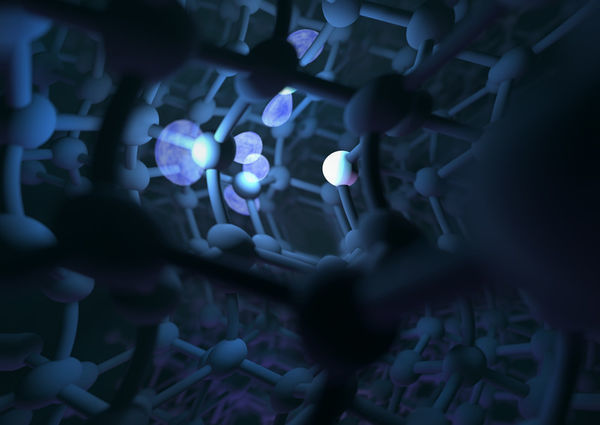
Superradiance: Quantum Effect Detected in Tiny Diamonds
"The effect has been predicted theoretically decades ago - but it is very hard to provide experimental evidence for it: "Superradiance" is the phenomenon of one atom giving off energy in the form of light and causing a large number of other atoms in its immediate vicinity to emit energy as well at the same time. This creates a short, intense flash of light. Up until now, this phenomenon could only be studied with free atoms (and with the use of special symmetries). Now, at TU Wien (Vienna), it was measured in a solid-state system. The team used nitrogen atoms, built into tiny diamonds that can be coupled with microwave radiation. The results have now been published in the journal "Nature Physics"." [...]
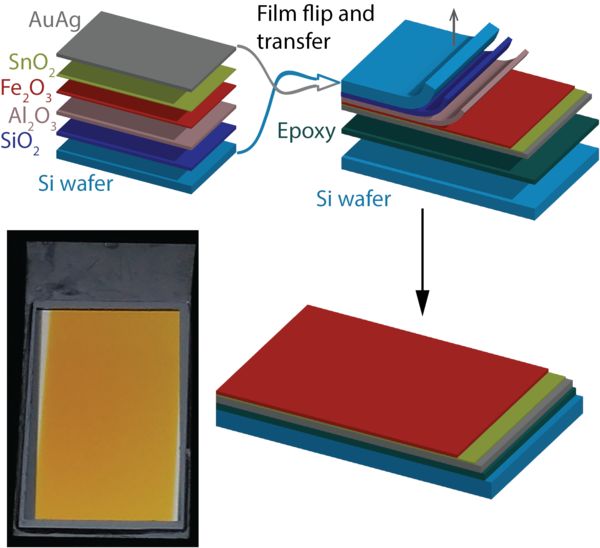
Researchers Develop New Method To Increase Electro-optical Device Efficiency
"Technion researchers have developed an innovative method for increasing the efficiency of electro-optical devices by increasing the interaction between light and matter. In findings published in Advanced Materials, the researchers report that they successfully implemented the method to produce a photoelectrochemical solar cell used to generate hydrogen from water, using solar energy. The new method stems from the production of meta-materials that increase the light-matter interaction in ultrathin absorber layers. These materials are made of multi-layer structures that combine thin layers of insulators, metals and semiconducting metal-oxides. The research was conducted by doctoral student Asaf Kay and postdoctoral researcher Dr. Barbara Scherrer with the guidance of the head of the research group, Prof. Avner Rothschild of the Department of Materials Science and Engineering. Hydrogen is a promising fuel because it is the lightest and cleanest fuel." [...]
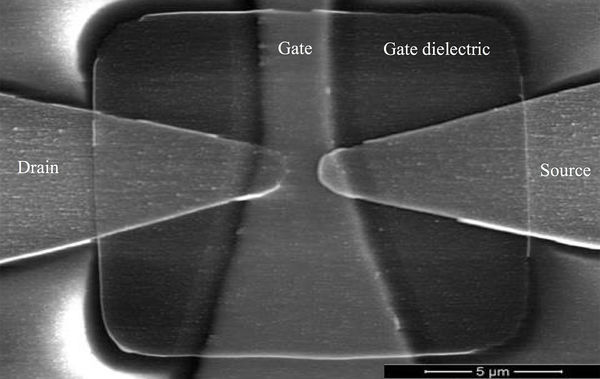
Squishy Transistors for Shark-Like Electrical Sensors
"Blending hydrogels with gold nanoparticles can produce a transistor for extra-sensitive sensors Hydrogels are essentially a gel in which the liquid component is water. They have been shown to act as a kind of power source or even as kind of stretchable touch screen that you could wear. Now researchers at the University of Utah have used hydrogels to make a switch for transistors that could be called “squishy” because of their flexibility and stretchable quality. In research described in IEEE Electron Device Letters, the Utah researchers fabricated a metal-oxide hydrogel field-effect transistor (MOHFET) with a channel composed of a hydrogel embedded with gold nanoparticles. The switching mechanism for the hydrogel is quite different from a typical silicon-based switch, which is turned on by making the channel more conducting. In gold nanoparticle switches, the particles are always conducting and they are brought closer to the device electrodes to turn on the device." [...]
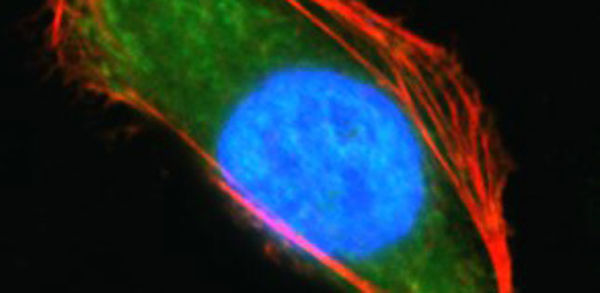
Terahertz wave activates filamentation of actin
"A novel possibility of manipulating cellular functions A team of researchers have discovered that terahertz (THz) wave irradiation activates the filamentation of actin protein. Drs. Shota Yamazaki and Masahiko Harata (Graduate School of Agricultural Science, Tohoku University); Dr. Yuichi Ogawa (Graduate School of Agriculture, Kyoto University); Dr. Hiromichi Hoshina (THz imaging and the sensing team at RIKEN); and Dr. Toshitaka Idehara (FIR-UF at University of Fukui) have made this important discovery, which offers a new possibility for the manipulation of cellular functions. Due to the recent development of high power THz (1012 Hz) wave sources, many researchers have begun to explore its application for material manipulation. One of the advantages of THz wave irradiation is its lower photon energy as compared to visible light. Therefore, THz wave prevents the ionization of molecules." [...]
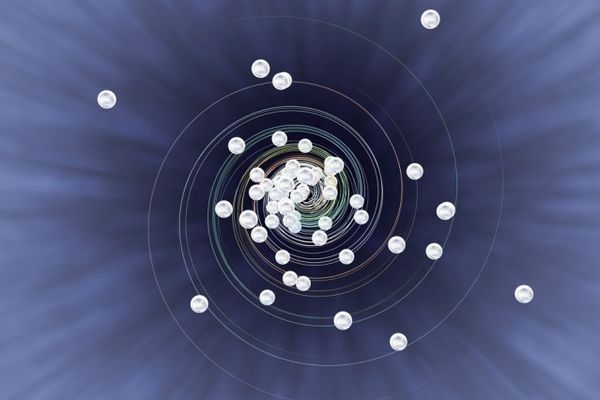
Fish-eye lens may entangle pairs of atoms
"Scientists find a theoretical optical device may have uses in quantum computing. Nearly 150 years ago, the physicist James Maxwell proposed that a circular lens that is thickest at its center, and that gradually thins out at its edges, should exhibit some fascinating optical behavior. Namely, when light is shone through such a lens, it should travel around in perfect circles, creating highly unusual, curved paths of light. He also noted that such a lens, at least broadly speaking, resembles the eye of a fish. The lens configuration he devised has since been known in physics as Maxwell’s fish-eye lens — a theoretical construct that is only slightly similar to commercially available fish-eye lenses for cameras and telescopes. Now scientists at MIT and Harvard University have for the first time studied this unique, theoretical lens from a quantum mechanical perspective, to see how individual atoms and photons may behave within the lens." [...]

New wood-metal hybrid for lightweight construction
"Wood foam and metal sponge – can they be combined? That was the question that experts at the Fraunhofer Institute for Wood Research, Wilhelm-Klauditz-Institut WKI delved into in a project entitled “HoMe Foam” – with HoMe being a German acronym for wood-metal – together with scientists from the Fraunhofer Institute for Machine Tools and Forming Technology IWU and the Fraunhofer Institute for Manufacturing Technology and Advanced Materials IFAM. As a result, the contrasting materials come together in perfect harmony. The innovative new material mix boasts excellent insulating properties and has a low bending strength. Nowadays, sustainability is a key aspect when developing new materials, where the main focus is on ensuring the input materials used come from renewable sources and that the product is recyclable at the end of its service life. Researchers at the Fraunhofer Institute for Wood Research, WKI are developing wood foams made entirely of wood." [...]
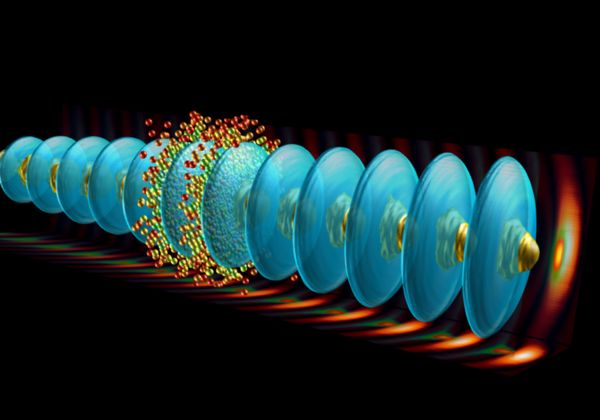
Electrons ride plasma wave
"First successful test of the particle accelerators of the future There is a good chance that soon a new door will open to physicists, offering them new insights into the mysteries of the universe. The international AWAKE collaboration has made a breakthrough in its efforts to build a new type of particle accelerator. The experiment, in which electrons surf on a plasma wave, accelerates particles with far less effort than is required with the LHC, for example, or with other particle accelerators used to date. Thus, physicists could bring about particle collisions with significantly more energy than has been possible so far. Studying the traces of these collisions may help scientists to gain new insights into the Big Bang and the structure of matter. However powerful the current apparatus such as the Large Hadron Collider (LHC) at CERN may be, it can already be foreseen that significantly more energy will be needed in order to answer questions about particle physics that remain open." [...]
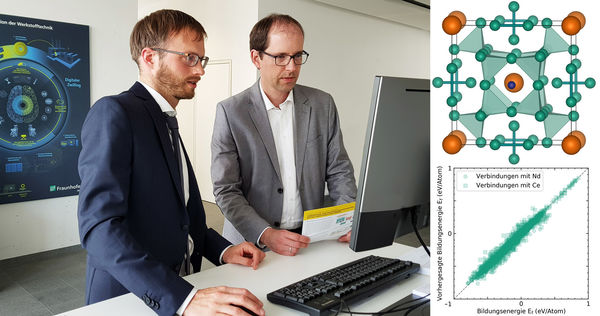
MagnetPredictor: predicting the magnetic properties of materials
"Permanent magnets used in electric cars and wind turbines currently contain rare earth metals. Reducing the amount of these elements in magnets is important, as mining them is harmful both to health and the environment. Researchers have now developed a new machine learning tool to assist in quickly and easily predicting the ferromagnetic crystal properties of novel material compositions. Renewable energy is a key technology for the future. However, both electric cars and wind turbines require large and strong permanent magnets. The inherent problem is that high-performance magnetic materials contain 12 to 17 percent rare earth elements, chiefly neodymium and samarium, but also dysprosium and terbium." [...]

Yale researchers 'teleport' a quantum gate
"Yale University researchers have demonstrated one of the key steps in building the architecture for modular quantum computers: the “teleportation” of a quantum gate between two qubits, on demand. The findings appear online Sept. 5 in the journal Nature. The key principle behind this new work is quantum teleportation, a unique feature of quantum mechanics that has previously been used to transmit unknown quantum states between two parties without physically sending the state itself. Using a theoretical protocol developed in the 1990s, Yale researchers experimentally demonstrated a quantum operation, or “gate,” without relying on any direct interaction. Such gates are necessary for quantum computation that relies on networks of separate quantum systems — an architecture that many researchers say can offset the errors that are inherent in quantum computing processors. Through the Yale Quantum Institute, a Yale research team led by principal investigator Robert Schoelkopf and former graduate student Kevin Chou is investigating a modular approach to quantum computing." [...]
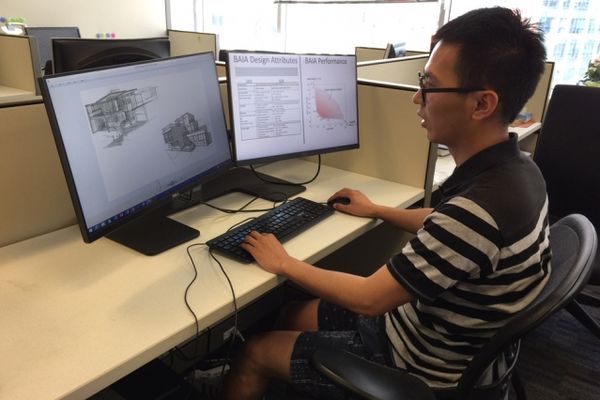
Software tool could help architects design efficient buildings
"MIT researchers develop inexpensive way to perform full lifecycle analysis of design choices as buildings are being planned. Typically, when architects or engineers design a new building, it’s only at the end of the process — if ever — that a lifecycle analysis of the building’s environmental impact is carried out. And by then, it may be too late to make significant changes. Now, a faster and easier system for doing such analyses could change all that, making the analysis an integral part of the design process from the beginning. The new process, described in the journal Building and Environment in a paper by MIT researchers Jeremy Gregory, Franz-Josef Ulm and Randolph Kirchain, and recent graduate Joshua Hester PhD ’18, is simple enough that it could be integrated into the software already used by building designers so that it becomes a seamless addition to their design process. Lifecycle analysis, known as LCA, is a process of examining all the materials; design elements; location and orientation; heating, cooling, and other energy systems; and expected ultimate disposal of a building, in terms of costs, environmental impacts, or both." [...]

Shen's Spectacular Supersolder
"Carnegie Mellon University's Sheng Shen has created a solder-like material called supersolder, with twice the thermal conductivity of conventional solders and a compliance higher by two to three orders of magnitude. In electronics, solder is used to connect two parts together. As a bridge, one of its most important functions is to transfer heat away from critical electronic components and toward the heat sink, which uses air or water to safely dissipate heat. As technological advances allow for the creation of smaller and more powerful computers and electronics — and with temperatures in computer chips reaching higher than 100°C — this heat dissipation function has become more crucial than ever. Conventional solders are limited in their ability to conduct heat effectively over a long lifetime, making heat dissipation an obstacle for further computing and electronics development. If these fields are to advance further, this crucial bottleneck will have to be overcome." [...]
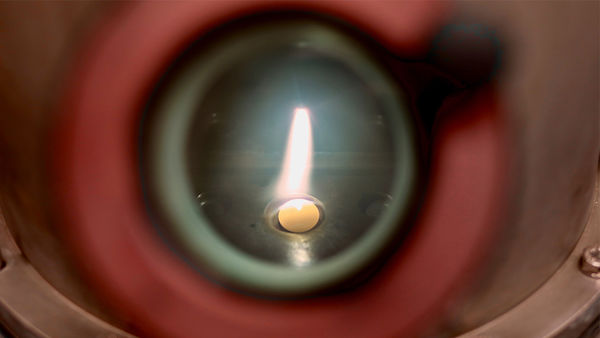
New smart materials could open new research field
"Serendipitous discovery could increase efficiency in jet engines, reduce plane noise, more A group of new smart materials discovered by researchers at Texas A&M University and their colleagues has the potential to significantly improve the efficiency of fuel burn in jet engines, cutting the cost of flying. The materials, which could also reduce airplane noise over residential areas, have additional applications in a variety of other industries. “What excites me is that we have just scratched the surface of something new that could not only open a completely new field of scientific research, but also enable new technologies,” said Dr. Ibrahim Karaman, Chevron Professor I and head of the university’s Department of Materials Science and Engineering. The work was published in Scripta Materialia. Karaman’s co-authors are Demircan Canadinc, William Trehern, and Ji Ma of Texas A&M, and Fanping Sun and Zaffir Chaudhry, Technical Fellow of the United Technologies Research Center (UTRC). The discovery is based on bringing together two relatively new areas of materials science involving metal alloys, or metals composed of two or more elements." [...]
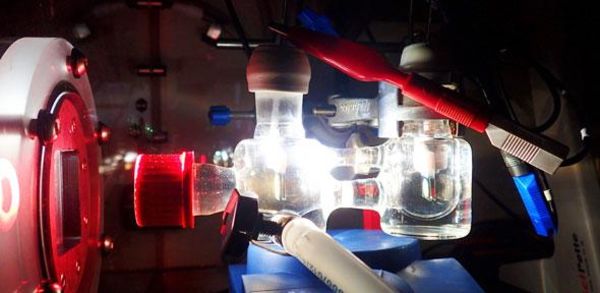
Scientists pioneer a new way to turn sunlight into fuel
"The quest to find new ways to harness solar power has taken a step forward after researchers successfully split water into hydrogen and oxygen by altering the photosynthetic machinery in plants. This could be a great platform for developing solar technologies. Katarzyna Sokół Photosynthesis is the process plants use to convert sunlight into energy. Oxygen is produced as a by-product of photosynthesis when the water absorbed by plants is ‘split’. It is one of the most important reactions on the planet because it is the source of nearly all of the world’s oxygen. Hydrogen which is produced when the water is split could potentially be a green and unlimited source of renewable energy." [...]

Physicists watch spin liquid turn into Mott insulator
"An international research team featuring scientists from the Terahertz Spectroscopy Lab at MIPT has made a direct observation of the Mott transition. In this phenomenon, the electrostatic repulsion of electrons in a metal causes it to lose the ability to conduct electricity, making it an insulator. By understanding the nature of this transition, it could be controlled and potentially used to develop new components for quantum computers. The research is reported in Nature Materials, the most frequently cited materials science journal with an impact factor close to 40. “In this study, we set up an experiment that enabled us to firstly observe the Mott transition from a metal to a dielectric in its pristine state. We examine the phenomenon in detail and compare the findings to theoretical predictions,” says Boris Gorshunov, who heads MIPT’s Terahertz Spectroscopy Lab." [...]
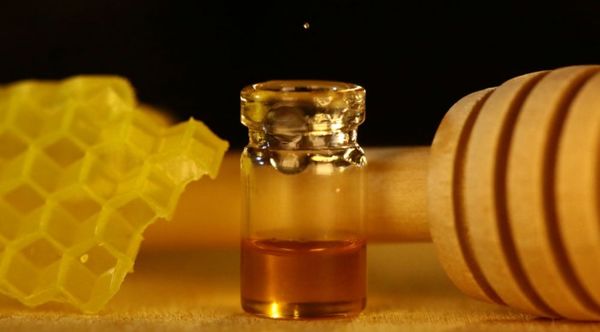
Printing with sound
"Researchers use acoustic forces to print droplets that couldn’t be printed before Harvard University researchers have developed a new printing method that uses soundwaves to generate droplets from liquids with an unprecedented range of composition and viscosity. This technique could finally enable the manufacturing of many new biopharmaceuticals, cosmetics, and food and expand the possibilities of optical and conductive materials. “By harnessing acoustic forces, we have created a new technology that enables myriad materials to be printed in a drop-on-demand manner,” said Jennifer Lewis, the Hansjorg Wyss Professor of Biologically Inspired Engineering at the Harvard John A. Paulson School of Engineering and Applied Sciences (SEAS) and the senior author of the paper. Lewis is also a Core Faculty Member at the Wyss Institute for Biologically Inspired Engineering and the Jianming Yu Professor of Arts and Sciences at Harvard. The research is published in Science Advances. Liquid droplets are used in many applications from printing ink on paper to creating microcapsules for drug delivery." [...]

Watching atoms and electrons at work
"Kiel layered crystals are used worldwide as a basis for exploring the nano-cosmos The properties of materials are determined by their atomic structure. If atoms and electrons change their positions, then the characteristics of a material also change. The complex processes that occur during these changes are being investigated by a working group at Kiel University (CAU), using a unique material: tantalum disulphide. The Kiel-based group specialises in the production of this layered crystal, and research teams around the world use their samples as the basis for experiments on dynamic processes in materials. Together with the Universities of Göttingen, Duisburg-Essen and Aarhus, three studies based on tantalum disulphide from Kiel have appeared recently, revealing previously-unknown phenomena in the movement of electrons and atoms. In the long term, the results could, for example, indicate how these movements could be controlled, thereby enabling properties of materials to be changed in a targeted manner." [...]
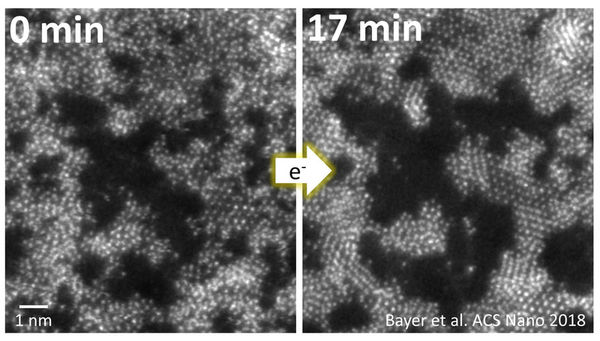
Watching two-dimensional materials grow
"Atomically thin crystals will play an ever greater role in future – but how can their crystallisation process be controlled? A new method is now opening up new possibilities. They are among the thinnest structures on earth: “two dimensional materials” are crystals which consist of only one or a few layers of atoms. They often display unusual properties, promising many new applications in opto-electronics and energy technology. One of these materials is 2D-molybdenum sulphide, an atomically thin layer of molybdenum and sulphur atoms. The production of such ultra-thin crystals is difficult." [...]

Cannibalistic materials feed on themselves to grow new nanostructures
"Scientists at the Department of Energy’s Oak Ridge National Laboratory induced a two-dimensional material to cannibalize itself for atomic “building blocks” from which stable structures formed. The findings, reported in Nature Communications, provide insights that may improve design of 2D materials for fast-charging energy-storage and electronic devices. “Under our experimental conditions, titanium and carbon atoms can spontaneously form an atomically thin layer of 2D transition-metal carbide, which was never observed before,” said Xiahan Sang of ORNL. He and ORNL’s Raymond Unocic led a team that performed in situ experiments using state-of-the-art scanning transmission electron microscopy (STEM), combined with theory-based simulations, to reveal the mechanism’s atomistic details. “This study is about determining the atomic-level mechanisms and kinetics that are responsible for forming new structures of a 2D transition-metal carbide such that new synthesis methods can be realized for this class of materials,” Unocic added. The starting material was a 2D ceramic called a MXene (pronounced “max een”)." [...]
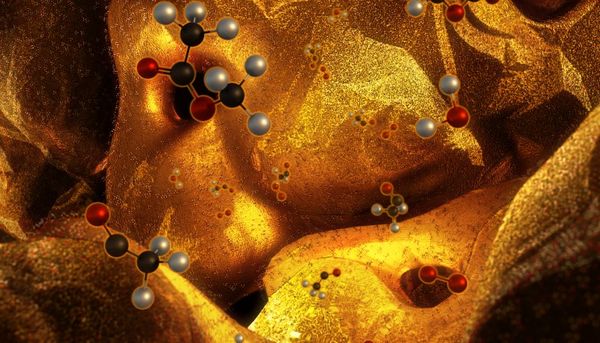
Hierarchical 3D printing of nanoporous gold could 'revolutionize' electrochemical reactor design
"Nanoporous metals are superior catalysts for chemical reactions due to their large surface area and high electrical conductivity, making them perfect candidates for applications such as electrochemical reactors, sensors and actuators. In a study published today in the journal Science Advances, Lawrence Livermore National Laboratory (LLNL) researchers, along with their counterparts at Harvard University, report on the hierarchical 3D printing of nanoporous gold, a proof of concept that researchers say could revolutionize the design of chemical reactors. “If you consider traditional machining processes, it’s time consuming and you waste a lot of materials — also, you don’t have the capability to create complex structures,” said LLNL postdoctoral researcher Zhen Qi, a co-author on the paper. “By using 3D printing we can realize macroporous structures with application-specific flow patterns. By creating hierarchical structures, we provide pathways for fast mass transport to take full advantage of the large surface area of nanoporous materials. It’s also a way to save materials, especially precious metals.” Combining 3D printing through extrusion-based direct ink writing and an alloying and dealloying process, researchers were able to engineer the nanoporous gold into three distinct scales, from the microscale down to the nanoscale, reporting the hierarchical structure “dramatically improves mass transport and reaction rates for both liquid and gases.” With the ability to manipulate the catalyst’s surface area to generate electrochemical reactions through 3D printing, researchers said the development could have a major impact on electrochemical plants, which today rely primarily on thermal energy." [...]
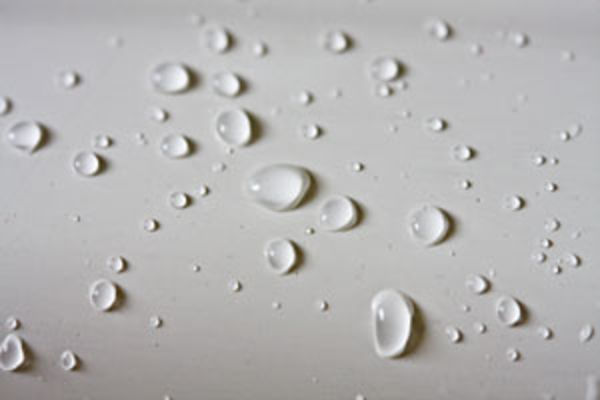
Tuning into the potential of phosphorene
"Better understanding of the wetting characteristics of phosphorene could pave the way for new applications in biological engineering A technique for investigating the wetting behavior of water on phosphorene — the single layer form of black phosphorus — has been developed by A*STAR researchers seeking to better understand properties that could enable its commercial applications. Phosphorene, unlike other commonly used 2D materials, such as graphene and molybdenum disulfide, possesses structural anisotropy, in which it exhibits different physical properties along axes in different directions. This property could allow phosphorene with tunable wettability to be fabricated for use in the biological sciences. Yet until now, little was known about the wetting behavior of this material. To realize the potential of phosphorene, however, requires a thorough understanding of how it interacts with biomolecules and fluids. This drove Chen Shuai, and colleagues from the A*STAR Institute of High Performance Computing to develop a technique for investigating the wetting characteristics of water droplets on phosphorene." [...]

The swing doctors: U-M physicist cracks code on material that works as both conductor, insulator
"Quantum materials are a type of odd substance that could be many times more efficient at conducting electricity through our iPhones than the commonly used conductor silicon—if only physicists can crack how the stuff works. A University of Michigan physicist has gotten one step closer with detailing a novel quantum material, ytterbium dodecaboride, or YbB12, and imaging how efficiently electricity is conducted through this material. The demonstration of this material’s conductivity will help contribute to scientists’ understanding of the spin, charge, and energy flow in these electromagnetic materials. YbB12 is a very clean crystal that is unusual in it shares the properties of both conductors and insulators. That is, the bulk interior of YbB12 is an insulator and doesn’t conduct electricity, while its surface is extraordinarily efficient at conducting electricity. But researchers needed to be able to measure exactly how good at conducting electricity this material is." [...]

Changing the way we search for antibiotics - with a $200, 3D-printed box
"A small, black box developed in a McMaster University lab could change the way scientists search for new antibiotics. The Printed Fluorescence Imaging Box – or PFIbox, for short – is capable of collecting massive amounts of data that will help researchers in the Michael G. DeGroote Institute for Infectious Disease Research in their quest to discover new antibiotics. The box allows scientists to analyze more than 6,000 samples of bacteria at a time. The tool uses LED lights to excite fluorescent proteins found in bacteria. It then wirelessly sends data to researchers studying how cells respond to antibiotics over time. The PFIbox’s nine structural parts can be 3D printed in about a day, snap together in minutes, and cost about $200." [...]
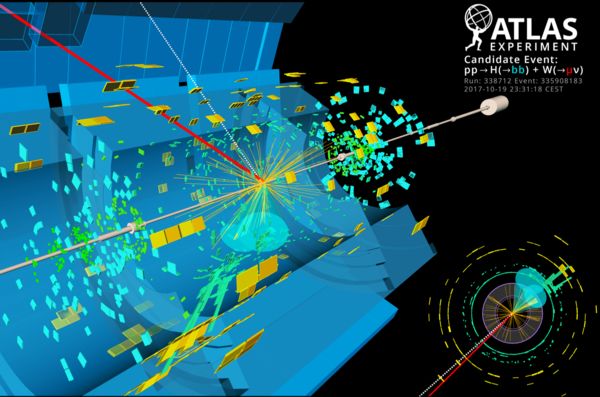
Long-sought decay of Higgs boson observed
"Six years after its discovery, the Higgs boson has at last been observed decaying to fundamental particles known as bottom quarks. The finding, presented today at CERN by the ATLAS and CMS collaborations at the Large Hadron Collider (LHC), is consistent with the hypothesis that the all-pervading quantum field behind the Higgs boson also gives mass to the bottom quark. Both teams have submitted their results for publication today. The Standard Model of particle physics predicts that about 60% of the time a Higgs boson will decay to a pair of bottom quarks, the second-heaviest of the six flavours of quarks. Testing this prediction is crucial because the result would either lend support to the Standard Model – which is built upon the idea that the Higgs field endows quarks and other fundamental particles with mass – or rock its foundations and point to new physics. Spotting this common Higgs-boson decay channel is anything but easy, as the six-year period since the discovery of the boson has shown." [...]
Modelos 3D
Com a disponibilidade de ferramentas que permitem dar azo a nossa imaginação na criação de peças 3D e espaços como o thingiverse para as publicar, esta rubrica apresenta alguns modelos selecionados que poderão ser úteis.

Brim & Support Cutter Cleaner
"It is a handy help for cleaning the print from Brim and supports. To use it you need mount in a Plexiglas cutter blade. For compatibility with all Blade, Long and Short, dont use two screws. Use Little part off universal glue. " [...]
Documentação
A documentação é parte essencial do processo de aprendizagem e a Internet além de artigos interessantes de explorar também tem alguma documentação em formato PDF interessante de ler. Todos os links aqui apresentados são para conteúdo disponibilizado livremente pelo editor do livro.
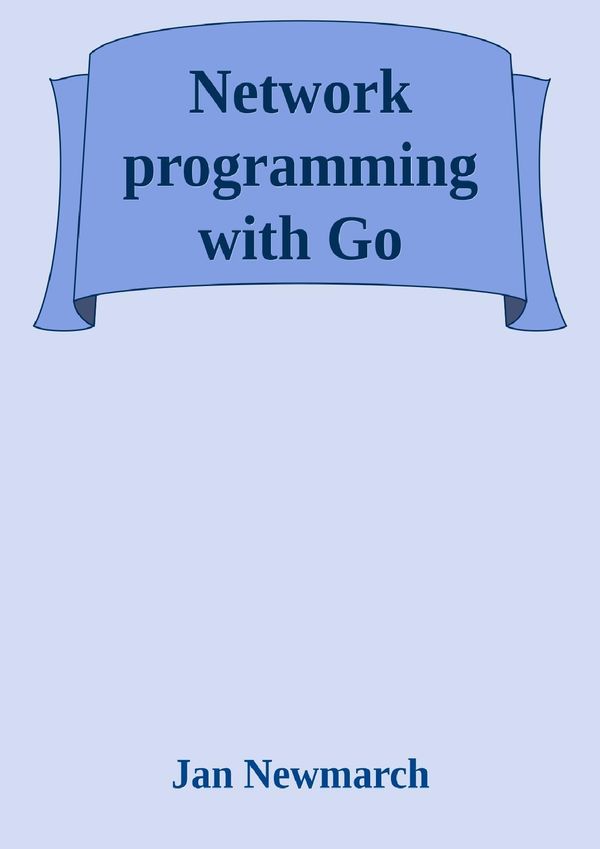
Network Programming with Go
"An e-book on building network applications using the Google Go programming language (Golang)" [...]
Projetos Maker
Diversos Projetos interessantes.
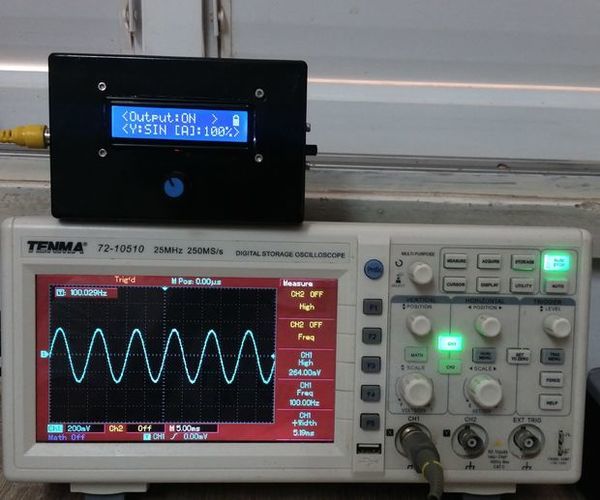
Portable Function Generator on Arduino
"Function generator is a very useful tool, especially when we are considering testing our circuit's response to a certain signal. In this instructable I'll describe the building sequence of small, easy to use, portable function generator. Features of the project: Fully digital control: No need for passive analog components. Modular design: Every sub-circuit is a pre-defined easy to use module. Output frequency: Available range from 0Hz to 10MHz. Simple control: Single rotary encoder with built-in push button." [...]
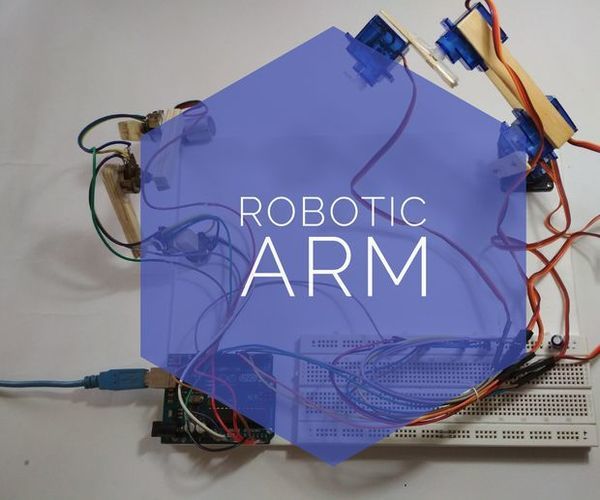
Simple & Smart Robotic Arm Using Arduino !!!
"In this instructable I will be making a simple robotic arm. That will be controlled using a master arm. The arm will remember moves and play in sequence. The concept isn't new I got the Idea from "mini robotic arm -by Stoerpeak" I wanted to make this for a long time, but back then I was totally noob and had no knowledge about programming. Now finally I am building one, Keeping it simple, cheap and sharing it with you all. So lets get started...." [...]
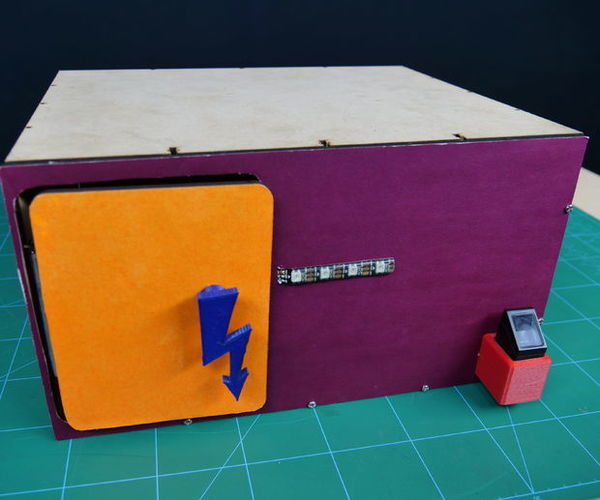
DIY Electronic Locker Using Fingerprint Sensor
"Bored of keeping track of countless locks and their keys? How about using your own fingerprint to unlock each and every safe in your house, just like your Smartphone? Sounds cool, right? Let's make an electronic Fingerprint locker that will keep all your secrets a secret from your enemies. And not only one, but up to ten unique fingerprints can be added to the system, for you and the people you trust with your life. ;) So, what are you waiting for?" [...]

Arduino and MIDI out
"In this article, we'll show how we can use musical instruments using Arduino. We will use the MIDI protocol, a serial protocol that sends messages to musical instruments. The instruments by the sent message know what note they are about to play. I will use the Korg Volca FM synthesizer in the preview. But you can use any musical instrument that has MIDI input. " [...]
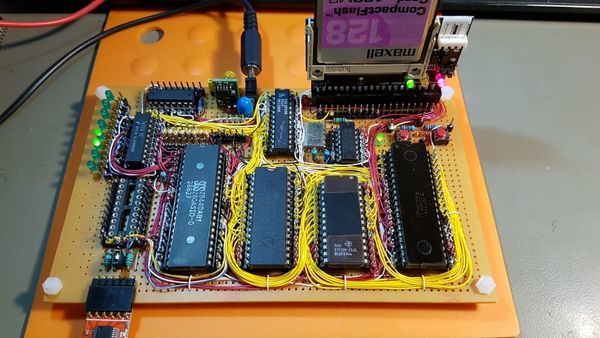
Z80-Board
"A Z80 computer wirewrapped on perfboard. The wirewrapping technique uses standard IC sockets and PCB header pins, so the components and wiring are on the same side of the board; this has many benefits: It's easier to see what you are connecting together. It creates a very neat and compact layout. Reworking is quicker and easier. No messy 'mat of wires' on the underside. Wirewrapping IC sockets are becoming expensive and harder to source." [...]
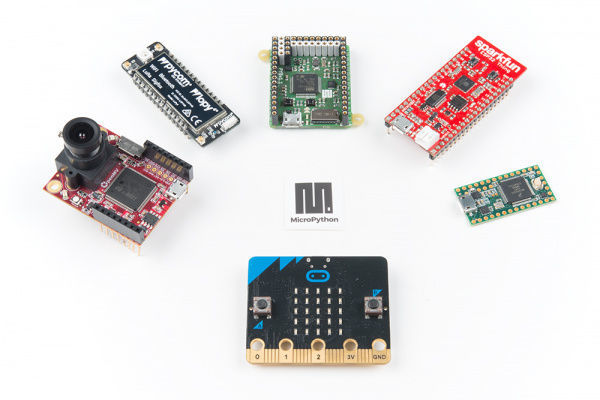
How to Load MicroPython on a Microcontroller Board
"MicroPython is a subset of the Python 3 language that has been pared down to run efficiently on several microcontrollers. If you are familiar with Python or looking for a quick way to write code for a microcontroller (that isn’t C/C++, Arduino, or assembly), MicroPython is a good option. Some development boards, like the pyboard and micro:bit, are capable of running MicroPython out of the box. Others, like the Teensy or ESP32, will require that you load the MicroPython interpreter onto the board first before it will run your MicroPython code. " [...]
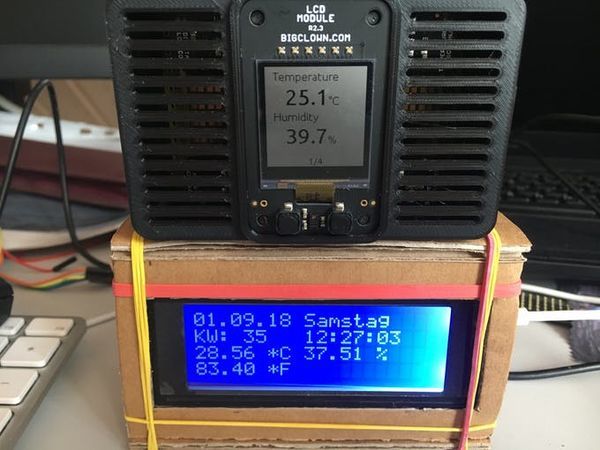
MyLCD20x4 Clock with Value-Added Information
"Use a Particle Photon, a SHT31-D sensor, and a cheap LCD20x4 to start your own clock project. Recycling good Since 07/2017, my desk clock powered by a Particle Photon runs smoothly with a BME280 and I thought it was time to change the structure slightly and to bring even a more precise temperature and humidity sensor to use. Here I decided for the SHT31-D with a chip from Sensirion, which is distributed as a breakout board by Adafruit. The data sheet speaks of deviations in the decimal range and so I describe the uncomplicated conversion while maintaining the transmission protocol I2C. " [...]
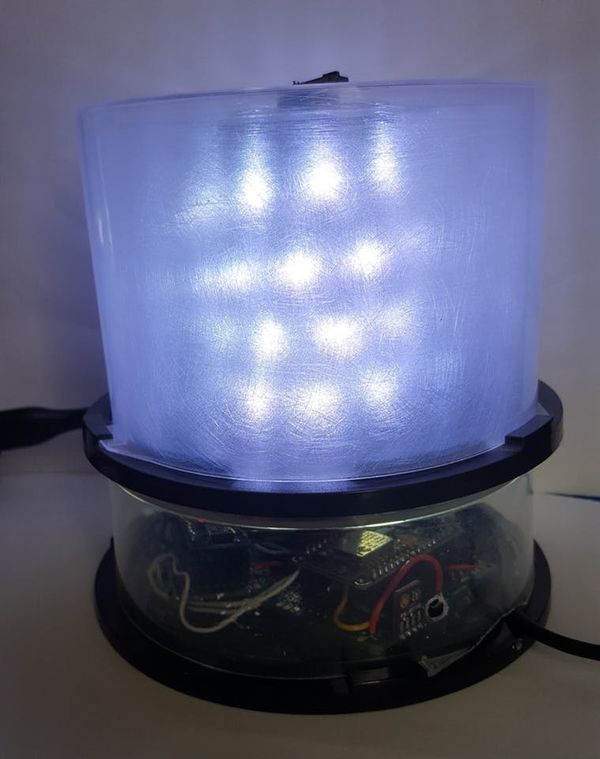
KatLight - The Coolest IoT Wonderlamp
"An IoT lamp with gesture seonsor, temperature sensor, and multiple light effects. Into For a very special woman, I needed a very special and unique present. Something really cool. How about a NeoPixel lamp, that can be controlled with a smartphone. And why not adding some really funky features? Like turning the lamp on/off by the wave of your hand." [...]
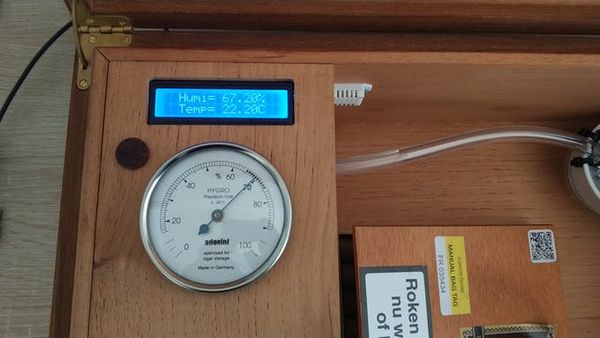
Humiduino
"An automated humidor using an Arduino — with or without building your own humidor. Introduction 'A cigar is as good as the memories you had when you smoked it.' I can agree on that, but a sharp and bitter cigar will probably make it a lot less enjoyable. That's why I wanted to build myself a Humidor. Storing a cigar at the right temperature and humidity is very important. Especially for long filler cigars like Cubans." [...]

Make a Colorful Infinity Mirror
"In my last instructable, I made an infinity mirror with white lights. This time I'm going to make one with colorful lights, using an LED strip with addressable LEDs. I'll be following a lot of the same steps from that last instructable, so I'm not going to go into much detail with those steps and focus more on what I'm doing different with this one. I recommend checking out my previous instructable to get more information on those steps. You can see that instructable here: Make a 2-Sided, Desktop Infinity Mirror" [...]

ATtiny13/13a/25/45/85 Programming Shield
"ATtiny13/13a/25/45/85 This is a great beginner soldering and prototyping board project. The ATtiny is a very capable microcontroller. This shield allows us to program it quickly and conveniently. Purpose The ATtiny doesn't come in the modular package that the Arduino UNO does. As the microcontroller comes bare, there is no immediate means of programming it. A standard USB's data lines use a serial communication protocol that is not recognized by the ATtiny." [...]
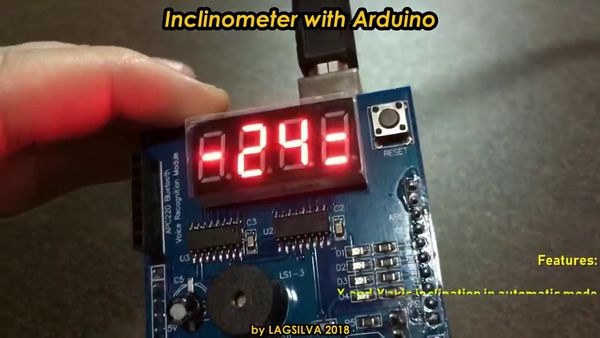
Simple Inclinometer With Arduino
"This project is about a simple inclinometer featuring auto rotation of display. This inclinometer can be rotated in any position keeping the digits readable even upside down! It is controlled by an Arduino 101 driven by accelerometers to read the tilt angle of X-Y axes. Additionally, there is a feature to show the ambient temperature in Celsius or in Fahrenheit degrees. The assemble is very simple and I hope you have fun using it! " [...]
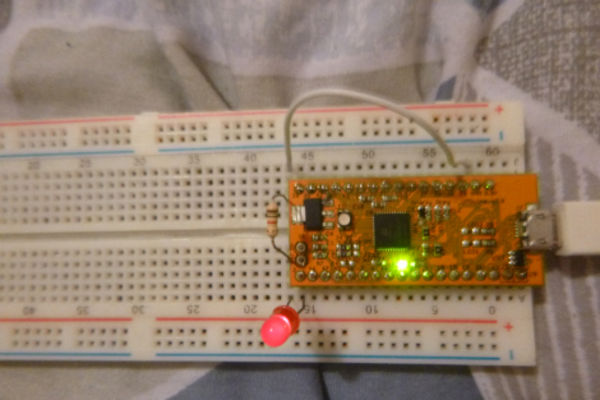
Lattice Ice40 Ultra Plus FPGA: Gnarly Grey Upduino - Tutorial 1: The Basics
"Long time no post! Now that’s out of the way… As ever, I’m always on the search for cheap electronics and this board is nearly mind blowing given both the price and form factor you can get it in. Enter the Gnarly Grey UPDuino v2.0 based on a Lattice iCE40UP5K FPGA featuring: 120Kbits of BRAM 1024Kbits of Single Port RAM Integrated PLL Integrated DSP units (MAC!) I2C and SPI IP Internal HF and LF oscillators LED driver PWM IP blocks 48pin QFN A pretty feature packed little guy for only $15.99. I’ve been looking for an FPGA of this size and form factor for a very long time and finding one at this price just so happens to be a bonus. The cheap price however comes with a few niggles, namely getting it up and running in the first place with the limited documentation." [...]

DIY - LAN Cable Tester
"There is nothing worse than running your drops only to realize that you have a fault in one of the cable runs. The best approach is to get it right in the first place by using a "LAN Cable Tester". Sometimes, cables can also tear because of poor material quality or bad installation or sometimes they get gnawed by animals. In this project, I am going to make a LAN cable tester with just a few basic electronics components. The entire project, excluding the battery cost me just a bit over $3. With this tester we can easily check RJ45 or RJ11 network cables for their continuity, sequence and if they have a short-circuit." [...]

Simple (hardware) Watch Dog Timer for Arduino Projects
"We all use and love the Arduino boards for our projects. But sometimes it can happen, that a software or hardware error causes a lot of frustration, by stopping out little board from running 24/7. For this reason Arduino has a built in WDT (Watch Dog Timer), but in some of my projects (working a lot with external libraries) I found that the on-board solution doesn't always work as expected. To resolve this issue, I have designed a simple external WDT, to monitor my project and reset the board if it seems to be stuck somewhere. " [...]

ChocoRobo - Autonomous Chocolate Delivery Robot
"A simple, easy to build face following robot made with off the shelf parts. Introduction Simple and easy to build face following robot with off-the-shelf parts for anyone to create. No need for expensive or specialized tools such as 3D printers, CNC machines, or laser cutters. Most of the items you can easily order from Adafruit or Amazon and probably already have laying around. The robot is basically a line following robot but instead of following a line, the robot will track to the faces it sees. Attach a container, box, basket, etc." [...]

Portable Function Generator on Arduino
"Function generator is a very useful tool, especially when we are considering testing our circuit's response to a certain signal. In this instructable I'll describe the building sequence of small, easy to use, portable function generator. Features of the project: Fully digital control: No need for passive analog components. Modular design: Every sub-circuit is a pre-defined easy to use module. Output frequency: Available range from 0Hz to 10MHz. Simple control: Single rotary encoder with built-in push button." [...]
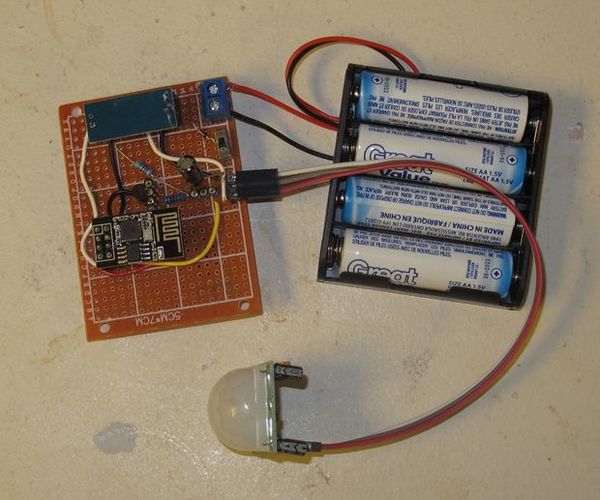
ESP-01 Motion Sensor With Deep Sleep
"I have been working on making homemade motion sensors that send an email message when triggered. There are many example instructables and other examples of doing this. I recently needed to do this with a battery operated PIR motion sensor and an ESP-01. The ESP-01 is very functional and has all the capabilities required so why not use the minimum and least expensive necessary? Added to the mix was another separate and remote ESP-01 module that triggered a buzzer when the motion sensor was triggered. The code and eventual circuit layout has been gathered from numerous sources across the web and I don't think I can identify them specifically." [...]
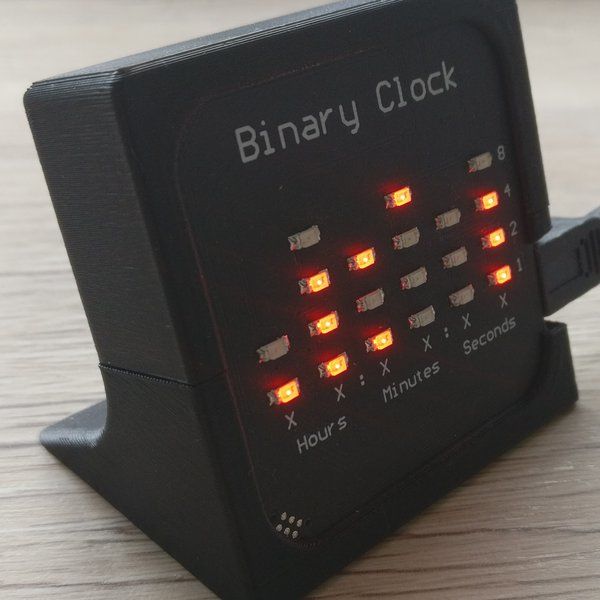
BCD Binary Clock for your desk
"A small BCD binary clock to put on your desk. It's USB powered and can display time, date and temperature. I just wanted a small clock to put on my desk. But me being me, I didn't just want any ordinary clock. So that's how this little project started. I decided to put as much information as possible on the clock, so even someone who doesn't know how to read BCD could easily understand it." [...]

Enginursday: A Glowing Guitar for Decadon
"I was recently approached by music producer Decadon to add lights to an already custom guitar to make it even more one-of-a-kind. Let's check out some of the challenges I faced. It’s not every day you get handed a guitar that has only two others of its kind in the world, and it’s an even rarer occasion when the owner trusts you to cover it in LEDs. In order to maintain this trust, I wanted to figure out some way to add the lighting effects that I wanted without affecting the structural integrity of the guitar whatsoever. I didn’t want to drill into or glue onto the guitar due to the lack of an available second chance, so I came up with a plan to sandwich the guitar in between two layers and support my various lighting mechanisms through that. " [...]

RF Transmitter and Receiver
"In this project, I will use RF modules with Pic 16f628a. It will be a short tutorial about rf. After you learn ho rf modules communicate with each other you can use these modules with pic microcontroller, ardunio or any microcontroller. I controlled RGB LEDs but If you can control many thing motors or relays. " [...]
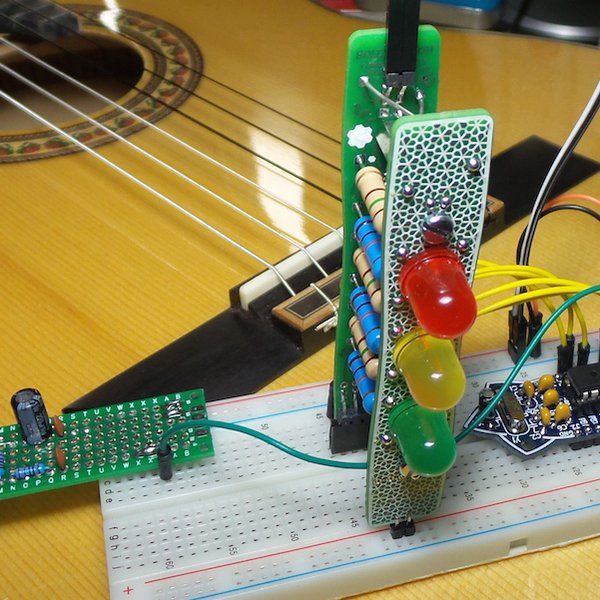
Cordwood I Guitar Tuner
"The Boldport Cordwood has 6 LEDs. My guitar has 6 strings. So let's make a tuner.. The Boldport Cordwood has six LEDs. Six is one of my favourite numbers .. like the number of strings on a standard guitar. So is it possible to use the Cordwood to detect (even tune) the six strings of a guitar?" [...]
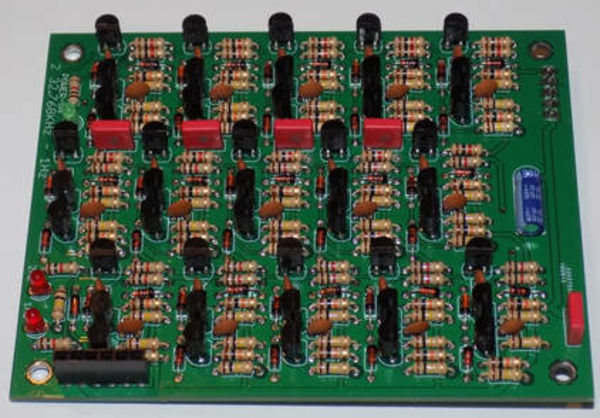
Transistor logic clock MkII
"This clock has been designed so that you can take it apart and see how each section works from the power supply up and you can watch the numbers travel through the boards. There are 283 transistors in this clock it uses a crystal oscillator for the main clock the clock is spread over nine boards and the clock is 14cm high 11cm wide and 9cm deep so it can easily stand on your desk. " [...]
That's all Folks!


